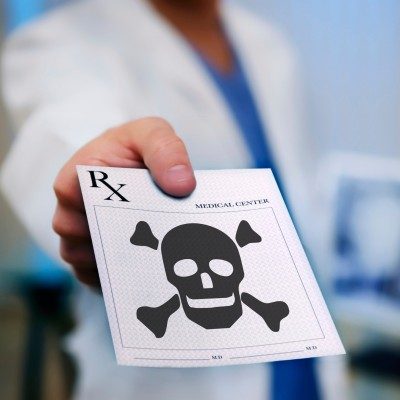Published on Nov. 11, 2014 By Erinn Hutkin, Special to U-T San Diegonoon There were 254 deaths in San Diego County last year that resulted from an overdose of prescription drugs, according to the county medical examiner’s office. Nationally, 105 people die daily across the United States from prescription drug overdoses, which is more than the number of deaths resulting from heroin and cocaine use combined, said Dr. Roneet Lev, who chairs a countywide prescription drug abuse medical task force. In many cases, she said, deaths result from taking drugs mixed with other drugs and/or alcohol. For instance, she said, there were four deaths last year that involved the over-the-counter allergy medicine Benadryl. She said nearly anything can be deadly if a person takes too much or mixes medicine with other substances. “There’s a saying … ‘One pill can kill you,’” she said. “It’s dosage-dependent and what you’re mixing it with.” Dr. David Sack, CEO of Promises Treatment Centers in LA, said the types of prescription drugs that people tend to overdose on generally fall into one of three categories: • Opioids: Pain relievers such as OxyContin, Percocet, Opana and Vicodin are prized for the calming sense of euphoria they give, which has been likened to heroin – also an opioid. He said because the pills can cost up to hundreds of dollars each on the street, users are increasingly turning to the now cheaper heroin. Opioids are extremely habit-forming and are often used with other drugs or alcohol, all of which can make them much more likely to cause hypoventilation, or respiratory depression, overdose and death. • Benzodiazepines: These act as tranquilizers or depressants to impart a soothing feeling of relaxation. Among the most popular ones are Xanax, Klonopin and Valium. These can be habit-forming, and misuse can lead to overdose death. • Stimulants: Amphetamines, prescribed for conditions such as ADHD, and called Adderall, Concerta or Ritalin, are often abused by people who want to focus or stay awake — truck drivers or students cramming for exams. The drugs latch onto the same receptors in the brain as cocaine and can become habit-forming. Repeated high doses can cause dangerous spikes in body temperature, which can lead to cardiovascular problems – even heart failure – and promote feelings of paranoia and hostility. He said abuse often starts when someone is prescribed a drug for a legitimate reason, such as pain relief after surgery. But because these drugs can be habit-forming, use can quickly spiral out of control. When that happens, the person will often switch into drug-seeking behavior when the prescription runs out, such as buying medication on the street, stealing from friends of family members medicine cabinets, or shopping around to find doctors willing to keep the supply coming. Yet for some people, particularly young ones, prescription drug use is recreational. “The appeal here is that prescription drugs are seen as providing an exceptional high while being both ‘safer’ than street drugs and easier to find,” said Sack. “They are usually as close as their parents’ and grandparents’ medicine cabinets, in fact. The tragedy of course, is that the drugs aren’t safer at all. Debra Jay, a national addiction expert and author of “It Takes a Family: A Cooperative Approach to Lasting Sobriety,” said close to 60 percent of overdoses involve mixing opioids with other drugs, most notably benzodiazepines; anti-epileptic and anti-Parkinson drugs; antipsychotic and neuroleptic drugs; and antidepressants, and other psychotropic drugs. She said about 52 million Americans have used a prescription drug for a nonmedical reason, with about 1 in 12 high school seniors reporting Vicodin abuse and 1 in 20 reporting OxyContin abuse. The greatest indicator, she said, is availability. Ninety-nine percent of all hydrocodone made worldwide are used in the U.S. In 2010, she said, 42 million prescriptions were written and dispensed. While men are more likely to die of a prescription painkiller than women, the gap is narrowing. According to the Centers for Disease Control and Prevention, women ages 45 to 54 are at highest risk for going to the hospital for prescription painkiller overdose. They are also more likely to be prescribed painkillers, given higher doses and use them longer than men. In fact, said Sack, CDC statistics show that of the 41,500 drug overdose deaths nationwide in 2012, 53 percent were related to pharmaceuticals. He said many of those who abuse or overdose on prescriptions get the drugs from their doctor and when the doctor won’t prescribe more, they shop around for a new doctor to write a prescription. In an attempt to stop doctor-shopping, California recently set up a prescription-drug monitoring program called CURES. It gives doctors a place to check the controlled substance history of those they see. But he noted it’s not mandatory that the medical community use the system. Experts said there are a variety of factors that are contributing to the abuse and overdose of prescription drugs, such as more advertising of prescription drugs, the creation of a slew of new drugs to treat depression, anxiety and attention deficit disorders; efforts by drug companies to market their products and to get doctors to prescribe them; and the structure of the medical community to where doctors have limited the time with patients, and that has, as Sack said “subtly encouraged the expedient of writing a prescription.” “In short, when used as prescribed, prescription drugs are generally safe,” he said. “But if misused, their addictive potential skyrockets.”
There were 254 deaths in San Diego County last year that resulted from an overdose of prescription drugs, according to the county medical examiner’s office. Nationally, 105 people die daily across the United States from prescription drug overdoses, which is more than the number of deaths resulting from heroin and cocaine use combined, said Dr. Roneet Lev, who chairs a countywide prescription drug abuse medical task force. In many cases, she said, deaths result from taking drugs mixed with other drugs and/or alcohol. For instance, she said, there were four deaths last year that involved the over-the-counter allergy medicine Benadryl. She said nearly anything can be deadly if a person takes too much or mixes medicine with other substances. “There’s a saying … ‘One pill can kill you,’” she said. “It’s dosage-dependent and what you’re mixing it with.” Dr. David Sack, CEO of Promises Treatment Centers in LA, said the types of prescription drugs that people tend to overdose on generally fall into one of three categories: • Opioids: Pain relievers such as OxyContin, Percocet, Opana and Vicodin are prized for the calming sense of euphoria they give, which has been likened to heroin – also an opioid. He said because the pills can cost up to hundreds of dollars each on the street, users are increasingly turning to the now cheaper heroin. Opioids are extremely habit-forming and are often used with other drugs or alcohol, all of which can make them much more likely to cause hypoventilation, or respiratory depression, overdose and death. • Benzodiazepines: These act as tranquilizers or depressants to impart a soothing feeling of relaxation. Among the most popular ones are Xanax, Klonopin and Valium. These can be habit-forming, and misuse can lead to overdose death. • Stimulants: Amphetamines, prescribed for conditions such as ADHD, and called Adderall, Concerta or Ritalin, are often abused by people who want to focus or stay awake — truck drivers or students cramming for exams. The drugs latch onto the same receptors in the brain as cocaine and can become habit-forming. Repeated high doses can cause dangerous spikes in body temperature, which can lead to cardiovascular problems – even heart failure – and promote feelings of paranoia and hostility. He said abuse often starts when someone is prescribed a drug for a legitimate reason, such as pain relief after surgery. But because these drugs can be habit-forming, use can quickly spiral out of control. When that happens, the person will often switch into drug-seeking behavior when the prescription runs out, such as buying medication on the street, stealing from friends of family members medicine cabinets, or shopping around to find doctors willing to keep the supply coming. Yet for some people, particularly young ones, prescription drug use is recreational. “The appeal here is that prescription drugs are seen as providing an exceptional high while being both ‘safer’ than street drugs and easier to find,” said Sack. “They are usually as close as their parents’ and grandparents’ medicine cabinets, in fact. The tragedy of course, is that the drugs aren’t safer at all. Debra Jay, a national addiction expert and author of “It Takes a Family: A Cooperative Approach to Lasting Sobriety,” said close to 60 percent of overdoses involve mixing opioids with other drugs, most notably benzodiazepines; anti-epileptic and anti-Parkinson drugs; antipsychotic and neuroleptic drugs; and antidepressants, and other psychotropic drugs. She said about 52 million Americans have used a prescription drug for a nonmedical reason, with about 1 in 12 high school seniors reporting Vicodin abuse and 1 in 20 reporting OxyContin abuse. The greatest indicator, she said, is availability. Ninety-nine percent of all hydrocodone made worldwide are used in the U.S. In 2010, she said, 42 million prescriptions were written and dispensed. While men are more likely to die of a prescription painkiller than women, the gap is narrowing. According to the Centers for Disease Control and Prevention, women ages 45 to 54 are at highest risk for going to the hospital for prescription painkiller overdose. They are also more likely to be prescribed painkillers, given higher doses and use them longer than men. In fact, said Sack, CDC statistics show that of the 41,500 drug overdose deaths nationwide in 2012, 53 percent were related to pharmaceuticals. He said many of those who abuse or overdose on prescriptions get the drugs from their doctor and when the doctor won’t prescribe more, they shop around for a new doctor to write a prescription. In an attempt to stop doctor-shopping, California recently set up a prescription-drug monitoring program called CURES. It gives doctors a place to check the controlled substance history of those they see. But he noted it’s not mandatory that the medical community use the system. Experts said there are a variety of factors that are contributing to the abuse and overdose of prescription drugs, such as more advertising of prescription drugs, the creation of a slew of new drugs to treat depression, anxiety and attention deficit disorders; efforts by drug companies to market their products and to get doctors to prescribe them; and the structure of the medical community to where doctors have limited the time with patients, and that has, as Sack said “subtly encouraged the expedient of writing a prescription.” “In short, when used as prescribed, prescription drugs are generally safe,” he said. “But if misused, their addictive potential skyrockets.”
Deaths from prescription drugs skyrocket




